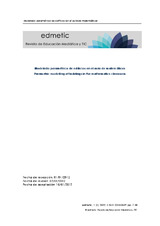Mostrar el registro sencillo del ítem
Modelado paramétrico de edificios en el aula de matemáticas
| dc.contributor.author | Falcón Ganfornina, Raúl Manuel | |
| dc.date.accessioned | 2014-02-04T12:35:49Z | |
| dc.date.available | 2014-02-04T12:35:49Z | |
| dc.date.issued | 2012 | |
| dc.identifier.issn | 2254-0059 | |
| dc.identifier.uri | http://hdl.handle.net/10396/11635 | |
| dc.description.abstract | El estudio analítico de curvas y superficies adquiere una importancia significativa en estudios universitarios asociados a Arquitectura y Edificación, si bien suele desarrollarse en el aula de Matemáticas únicamente a nivel teórico. No obstante, cualquier herramienta informática de diseño gráfico que utilice el alumnado a lo largo de su vida académica y profesional a la hora de modelar proyectos arquitectónicos se basa internamente en una computación matemática de todos y cada uno de los elementos que intervienen en el mismo, si bien el usuario no llega a vislumbrar el vínculo existente entre su proyecto y la base matemática en la que se fundamenta. El uso de herramientas informáticas que permitan modelar curvas y superficies a partir de sus ecuaciones paramétricas se convierte por tanto en un nexo de unión, que se potencia aún más en cuanto se procede a modelar construcciones arquitectónicas reales. En este sentido, el presente artículo muestra cómo, haciendo uso de su conocimiento matemático y de la información disponible en internet, el alumnado de la asignatura de Matemática Aplicada a la Edificación en el Grado de Ingeniería de Edificación de la Universidad de Sevilla ha realizado como experiencia docente el modelado matemático de un conjunto de edificios de estructura no trivial. La mejora del rendimiento académico es también analizada. | es_ES |
| dc.description.abstract | The analytical study of curves and surfaces is of significant importance in both Architecture and Building Engineering Degrees, although it is usually taught in the Mathematics classroom only from a theoretical point of view. Nevertheless, although students do not discern the existing link between both fields, any Computer Aided Design system which they use in their academic and professional life to model architectonical projects is implicitly based on a mathematical computation of each and every element which takes part in it. The use of software which can model curves and surfaces starting from their parametric equations is therefore an important nexus which can be better exploited when real architectonical constructions are considered. In this regard, the current paper shows how, by using their mathematical knowledge and the information available on the internet, the students of Applied Mathematics for Building Construction in the Building Engineering Degree of the University of Seville have developed, within a teaching experience, the mathematical modelling of a set of buildings with a non-trivial structure. The improvement of the academic performance is also analyzed | es_ES |
| dc.format.mimetype | application/pdf | es_ES |
| dc.language.iso | spa | es_ES |
| dc.publisher | Universidad de Córdoba | es_ES |
| dc.rights | https://creativecommons.org/licenses/by/3.0/ | es_ES |
| dc.source | Edmetic 1(2), 7-28 (2012) | es_ES |
| dc.subject | Uso didáctico del ordenador | es_ES |
| dc.subject | Geometría | es_ES |
| dc.subject | Arquitectura | es_ES |
| dc.subject | Modelado | es_ES |
| dc.title | Modelado paramétrico de edificios en el aula de matemáticas | es_ES |
| dc.title.alternative | Parametric modelling of buildings in the mathematics classroom | es_ES |
| dc.type | info:eu-repo/semantics/article | es_ES |
| dc.relation.publisherversion | http://www.uco.es/ucopress/ojs/index.php/edmetic/index | es_ES |
| dc.rights.accessRights | info:eu-repo/semantics/openAccess | es_ES |

